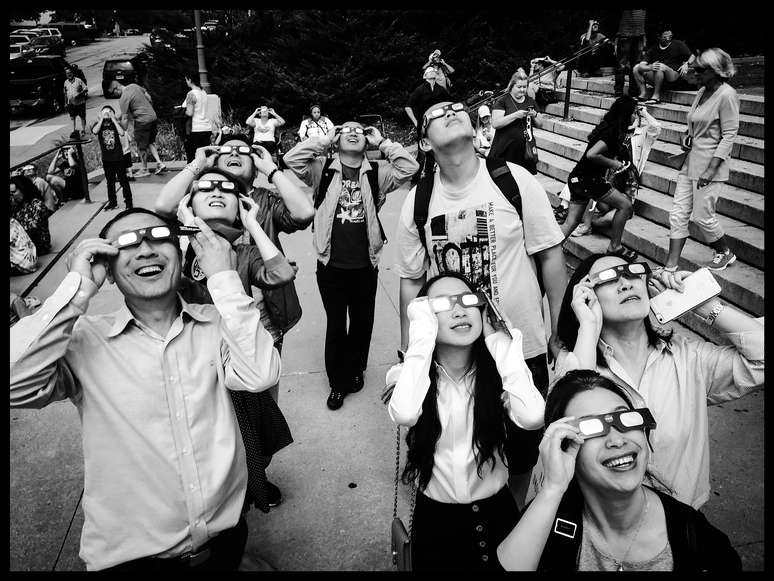Events such as the eclipse, ring of fire and meteor shower can be good excuses to travel to the United States, Morocco, Australia, Chile…
A range of astronomical phenomena are expected to occur during 2024, from a “ring of fire” eclipse, a meteor shower to a total solar eclipse. Another presence in this list of phenomena visible from Earth is comet A3. A survey conducted by Booking.com revealed that nine out of ten Brazilian travelers consider astronomical tourism an excellent motivation for traveling. The accommodation booking company has selected six unmissable events in 2024, ideal destinations to observe them and, of course, hotel recommendations.
Total solar eclipse (April 8) – Canandaigua, New York, United States
In April, the Moon will affect daylight during a total solar eclipse that can be seen in fifteen U.S. states, three Mexican states and four Canadian provinces. This phenomenon won’t happen again until 2044, so astronomy-loving travelers will have the opportunity to watch the Moon completely eclipse the Sun and block the light for a few moments. The west-central region of New York State, more precisely the Finger Lakes (an area full of lakes, hills and waterfalls) offers the perfect setting. On the afternoon of April 8, when the sun sets, the city of Canandaigua, located on the top of the lake of the same name, will be invaded by the darkness of the sky, offering the possibility of seeing the phenomenon reflected in the water. waters for almost 3 minutes. An outdoor paradise, the Finger Lakes are the state’s premier wine region.
Where stay: A good option is to watch the eclipse at The Lake House in Canandaigua, which hosts a party for the occasion, complete with glasses, souvenir blanket, canapés, cocktails and shows. This luxury resort, located in the Finger Lakes, features rooms with balconies and offers amenities such as a heated lakeside pool, hot tub, and boat trips in the warmer months. Guests can enjoy dishes made from fresh, locally sourced ingredients at the Rose Tavern restaurant or enjoy a beer with a burger at the Sand Bar.
Lyrid meteor shower (22 and 23 April) – Todra Gorges, Morocco
One of Earth’s oldest annual meteor showers, this astronomical event reaches its peak on April 22 and 23, when it will be possible to see 10 to 20 meteors per hour. The Northern Hemisphere is the best place to witness this spectacle. To make the most of it without worrying about interference from moonlight or light pollution, viewers can go to Todra Gorges, in the Moroccan Sahara. In the rugged terrain of the Atlas Mountains, this geological marvel of deep valleys carved out of limestone has earned the nickname “Morocco’s Grand Canyon.” Once at their destination, travelers can take part in the half-day walk through the Todra Gorges, which passes through gardens, palm groves and crystal-clear rivers.
Where stay: Auberge Le Festival Todra Gorge is located in the Atlas Mountains, in a privileged place for observing the meteor shower. The rooms are decorated in Berber style. In addition to the night dedicated to stargazing, you can enjoy other activities, such as rock climbing and off-road adventures.
Eta Aquarids meteorological shower (6 and 7 May) – Coonabarabran, Australia
Debris created by Halley’s Comet will send meteors toward Earth this year, peaking on May 6 and 7, with around 10 to 20 shooting stars appearing per hour. Although meteor showers can be observed all over the world, those in the Southern Hemisphere have greater visibility than the Eta Aquarids. OR Warrumbungle National Park, certified by the International Dark-Sky Association (IDA) for exceptionally starry nights, it offers a privileged place for those who want to follow the event. Located in the region of Orana, in New South Wales, Warrumbungle is Australia’s first Dark Sky Park and a suitable location for overnight camping (although you need to book several months in advance). During the day, the park hosts trails around its rocky and volcanic mountains, in a landscape full of eucalyptus trees. At night the sky can be seen without any interference thanks to stringent measures that offer protection from light pollution. The nearest town is Coonabarabran, known as the “astronomy capital of Australia”, and fans can visit Siding Spring Observatory to see Australia’s largest telescopes up close or Milroy Observatory to learn about the night sky.
Where stay: Pilliga Pottery Creative Farmstay is a short drive away Coonabarabran Comes from Warrumbungle National Park. Equipped with its own water supply and solar power system, this sustainable structure is located on the edge of Pilliga Forest, a great place for meteor shower viewing. Guests have the option of camping under the stars or staying in secluded rooms, which feature wooden balconies overlooking the hills. The property features a saltwater pool, barbecue area, pottery classes, and a café with locally sourced foods such as ice cream Pilliga.
Perseid meteor shower (from 11 to 13 August) – Joshua tree, California, United States
One of the largest natural phenomena, the Perseids will produce 50 to 100 meteors per hour this year, at an average speed of 58 km per second. Although the Moon waxes in mid-August, after sunset, viewers at lower latitudes north of the Equator will have plenty of time before sunrise to observe the phenomenon. To observe from a place with good visibility, you can camp on the Joshua Tree National Park, certified by the International Dark-Sky Association (IDA) and famous for its cloudless sky and beauty. Named after the native tree, this 321,000-hectare desert region, about 2 hours from Los Angeles, offers diverse experiences for travelers, such as hiking, climbing and birdwatching, as well as being a scenic spot for admiring the sunrise and sunset. For stargazing, it’s worth participating in stargazing with Joshua Tree professionals and spending a night in the park using state-of-the-art telescopes.
Where stay: guests can be surrounded by nature at @Marbella Lane – The Wine Mine Desert Escape, just steps from the west entrance of Joshua Tree National Park. This four-bedroom vacation home is ideal for families and groups of friends and offers private parking and a patio for outdoor dining with mountain views and a hot tub.
Eclipse with “ring of fire” (October 2) – Hanga Roa, Easter Island, Chile
Astronomy enthusiasts will have the chance to observe the “Ring of Fire” eclipse in remote areas of Argentina, Chile and Easter Island. During this celestial convergence, lasting about 7 minutes, the Moon will pass between the Earth and the Sun, forming a bright frame. For those who want to live a unique experience, the Easter island, The remote South Pacific destination off the coast of Chile, “inhabited” by huge moai, offers a mystical backdrop for the eclipse. Because the landward side of the island blocks the winds, this destination offers clear skies so travelers can watch the spectacle from the beach or from the ceremonial village of Orongo, a place that sits on the edge of a volcanic caldera. Known as “Rapa Nui” in Polynesian, Easter Island and its main city, Hanga Roa, are rich in history, culture and nature. To delve deeper into archaeological mysteries, it is worth taking the Easter Island Moai Archaeological Tour: Ahu Akivi, Ahu Tahai and Puna Pauâ Quarry and learn about the moai that have intrigued the world for centuries.
Where stay: Hare Nua Hotel Boutique is located near Pea Beach and Ahu Tahai Archaeological Site, ideal locations for eclipse viewing. Surrounded by greenery, this retreat features a wellness center and spa, as well as an outdoor wooden pool and a hot tub. The rooms are decorated with Polynesian artwork. Guests can get the full Easter Island experience at this hotel, which serves as a good base for sightseeing, as well as offering activities ranging from hiking to windsurfing and snorkeling.
Geminid Meteorological Shower (December 13 & 14) – Glenmore, Cairngorms, UK
The Geminid meteor shower will be one of the busiest astronomical spectacles of 2024. Its peak will coincide with the crescent moon, but, if the sky is clear, it will be possible to see around 120 shooting stars per hour. Since this celestial rain is more visible to those in the Northern Hemisphere, a good idea is to visit the world’s northernmost dark park, which offers an incredible view of the sky. Located in the Scottish Highlands, in the Tomintoul and Glenlivet areas Cairngorms Dark Sky Park They have observation points and broad horizons. The Cairngorms National Park and Glenfiddich Distillery Tour tours the park throughout the day and concludes with a visit to a famous whiskey distillery, while the private, guided Cairngorm Mountains Walking Tour takes travelers to the highest peaks with panoramic views about nature and the possibility of seeing red squirrels and eagles of different species.
Where stay: located in the Cairngorms National Park, IL Cairngorm Lodge Youth Hostel, in Glenmore, is the ideal place to observe the Geminid meteor shower, with views towards the Northern Couriers. Just a short walk from the Cairngorm Mountain Railway, winter sports area and Loch Morlich, home to sandy beaches and pine forests, this accommodation is perfect for those who love spending time outdoors. A Scottish breakfast and hot meals ensure comfort. The property features private rooms and bicycle storage.
Source: Terra
Ben Stock is a lifestyle journalist and author at Gossipify. He writes about topics such as health, wellness, travel, food and home decor. He provides practical advice and inspiration to improve well-being, keeps readers up to date with latest lifestyle news and trends, known for his engaging writing style, in-depth analysis and unique perspectives.



-1iyq160aoa4ag.png)

![Everything starts here: What awaits you on Thursday of September 18, 2025 in the 1266 episode [SPOILERS] Everything starts here: What awaits you on Thursday of September 18, 2025 in the 1266 episode [SPOILERS]](https://fr.web.img3.acsta.net/img/44/34/4434fec4599e79e4c76ca28c3f25362a.jpg)



